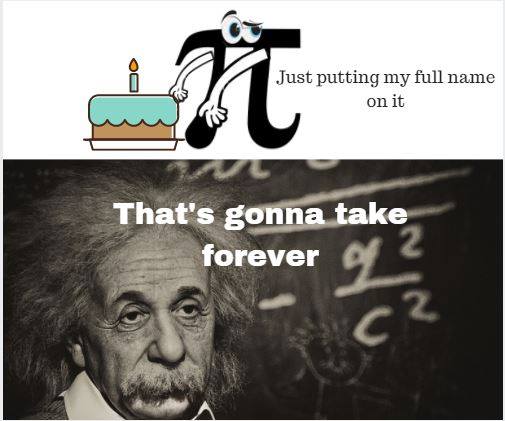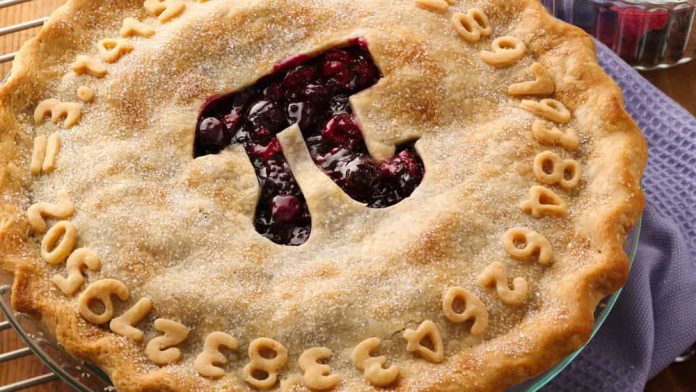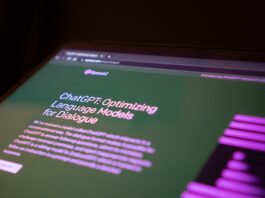I confess, math crawls like a snail into my head. The concepts, though quite easy, somehow are very difficult to grasp. I was introduced to pi when I was in the 8th standard. The chapter was about circles. I didn’t understand a fly about pi, except that if I saw a pi I should substitute it with 3.14.

Each has a unique way of understanding life and its ways. Some look up to role models, some learn from their family, some learn by experience and some by books. For me, works of fiction were my gurus. During my second year of college, I read a book called “CONTACT” by Carl Sagan. It’s also now a motion picture going by the same name, starring Matthew McConaughey and Jodie Foster. As always, the book is better than the movie. So, among the many other things I learnt from it, I learnt the meaning of PI. This was truly the first time I learnt mathematics from a completely different, fun and intriguing way. I wanted to share an extract from the book. It’s in the author’s own words- an explanation to Pi.

In the seventh grade, they were studying “Pi”. It was a Greek letter that looked like the architecture at Stonehenge, in England: two vertical pillars with a crossbar at top. If you measured the circumference of a circle and then divided it by the diameter of the circle, that was pi. At home, Ellie took the top of a mayonnaise jar, wrapped a string around it, straightened the string out, and with a ruler measured the circle’s circumference. She did the same with the diameter, and by long division divided the one number by the other. She got 3.21. That seemed simple enough.
The next day the teacher, Mr.Weisbrod, said that π was about 22/7, about 3.1416. But actually, if you wanted to be exact, it was a decimal that went on and on forever without repeating the pattern of numbers. Forever, Ellie thought. She raised her hand. It was the beginning of the school year and she had not asked any questions in this class.
“How could anybody know that the decimals go on and on forever?”
“That’s just the way it is,” said the teacher with some asperity.
“But why? How do you know? How can you count decimals forever?”
“Miss Arroway”- he was consulting his class list- “this is a stupid question. You’re wasting the class’s time.”
No one had ever called Ellie stupid before, and she found herself bursting into tears. Billy Hortsman, who sat next to her, gently reached out and placed his hand over hers. His father had recently been indicted for tampering with the odometers on the used cars he sold, so Billy was sensitive to public humiliation. Ellie ran out of the class sobbing.
After school she bicycled to the library at the nearby college to look through books on mathematics. As nearly as she could figure out from what she read, her question wasn’t all that stupid. According to the Bible, the ancient Hebrews had apparently thought that π was exactly equal to three. The Greeks and Romans, who knew lots of things about mathematics, had no idea that the digits in π went on forever without repeating. It was a fact that had been discovered only about 250 years ago. How was she expected to know if she couldn’t ask questions? But Mr. Weisbrod had been right about the first few digits. Pi wasn’t 3.21. Maybe the mayonnaise lid had been a little squashed, not a perfect circle. Or maybe she’d been sloppy in measuring the string. Even if she’d been much more careful, though, they couldn’t expect her to measure an infinite number of decimals.
There was another possibility, though. You could calculate pi as accurately as you wanted. If you knew something called calculus, you could prove formulas for π that would let you calculate it to as many decimals as you had time for. The book listed formulas for PI divided by four. Some of them she couldn’t understand at all. But there were some that dazzled her: π/4, the book said, was the same as 1 – ⅓ + ⅕ – 1/7 + …., with the fractions continuing on forever. Quickly she tried to work it out, adding and subtracting the fractions alternately. The sum would bounce from being bigger than π/4 to being smaller than π/4, but after a while you could see that this series of numbers was on a beeline for the right answer. You could never get there exactly, but you could get as close as you wanted if you were very patient. It seemed to her a miracle that the shape of every circle in the world was connected with this series of fractions. How could circles know about fractions? She was determined to learn calculus.
The book said something else: π was called a “transcendental number”. There was no equation with ordinary numbers in it that could give you π unless it was infinitely long. She had already taught herself a little algebra and understood what this meant. And π wasn’t the only transcendental number. In fact, there was an infinity of transcendental numbers. More than that, there were infinitely more transcendental numbers than ordinary numbers, even though π was the only one of them she had ever heard of. In more ways than one, π was tied to infinity.
She had caught a glimpse of something majestic. Hiding between all the ordinary numbers was an infinity of transcendental numbers whose presence you would never have guessed unless you looked deeply into mathematics. Every now and then one of them, like π, would pop up unexpectedly in everyday life. But most of them- were hiding, minding their own business, almost certainly unglimpsed by the irritable Mr Weisbrod.

You’ll never know what you’ll find in a book. That’s probably why it’s called the treasure trove of knowledge. Happy Pie Day Y’all!




